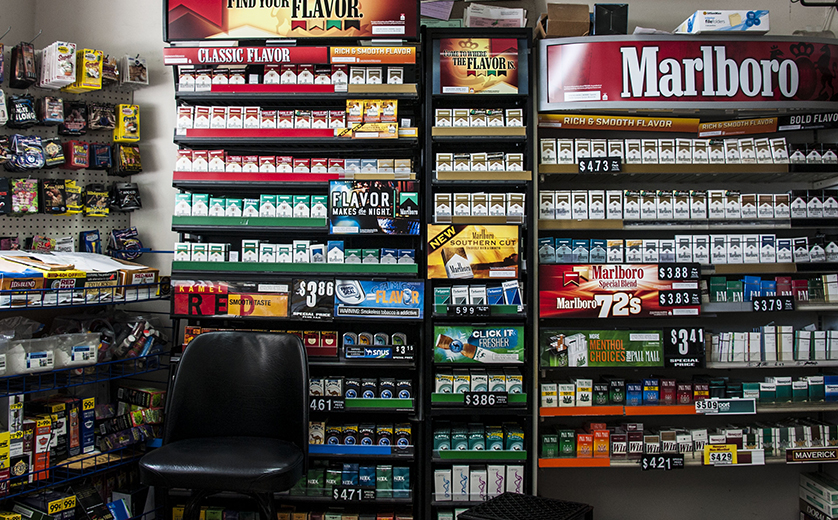Cigarette ads have long been absent from television, radio and billboards in the United States due to federal bans. But that doesn’t mean the tobacco industry isn’t pitching its products to potential buyers.
“Tobacco is the most heavily marketed product in the world, but that marketing is largely invisible,” said Douglas Luke, professor at the Brown School and director of the Center for Public Health Systems Science. Today’s marketing is largely occurring elsewhere, much of it at the 380,000 locations where tobacco products are sold: convenience stores, gas stations and other retail outlets.
Restricting how tobacco is marketed at these places is one of the newest core strategies to reduce smoking, but the least researched. That’s why longtime tobacco-control researchers like Luke are focusing their investigatory skills on the retail environment.
In collaboration with researchers at the University of North Carolina and Stanford University, a Brown School team led by Luke is just completing a five-year study of retail tobacco control policies funded by the National Cancer Institute. It’s called ASPiRE: Advancing Science and Policy in the Retail Environment. It was one of seven NCI grants to conduct tobacco control research of relevance to state and local tobacco control efforts. The national focus was prompted by the Family Smoking and Prevention Act of 2009, which reinforced the powers of states and local communities to regulate retail sales of tobacco.
Luke said the big takeaway from the research was that more and more states and communities are initiating efforts to restrict retail sales with policies like age restrictions and limitations on the density of tobacco retailers.
“It’s a rapidly increasing and evolving area,” he said. “Communities are not waiting for the science.” That’s a good thing, he added, because it has turned states and municipalities into laboratories for seeing what works and what doesn’t. Now the science needs to harvest that evidence and examine it.
The major findings by the ASPiRE collaboration have been published in several papers and reports, among them:
- A study that found state activities to regulate retail sales of tobacco nearly doubled between 2012 and 2014, but that much of the activity was directed at e-cigarettes, perhaps the least harmful tobacco product. It found less progress in other, more effective tobacco-control efforts, such as non-tax approaches to increase prices, which reduces youth smoking.
“State and local programs require more capacity to promote evidence-based policymaking,” the authors wrote. They suggested the U.S. Food and Drug Administration should continue to strengthen regulation of tobacco products, thus freeing state and local programs to pursue other innovative policies the FDA cannot.
- Another paper said strong partnerships, local data and support from elected officials were key to passage of New York City retail tobacco restrictions aimed at reducing youth smoking. The new law raised the minimum age to buy tobacco from 18 to 21, restricted price discounts, established minimum price and packaging requirements, and increased penalties for tax evasion. Among the most progressive legislation in the nation, the laws have been adopted by other local governments.
The authors suggested several lessons for other communities that want to pass similar legislation, including direct engagement of policymakers with constituents; inclusion of supportive retailers early in the process; and efforts to build on existing policies.
- Three comprehensive Reports to the Nation reviewed the changing retail landscape and retail tobacco-control efforts. The reports examined successful policy efforts, made recommendations to tobacco-control professionals across the country, and provided resources for future efforts.
- A commentary published in the Journal of the American Medical Association called for renewed action to address states where tobacco control efforts have stalled. It suggested more policy innovation at the local level, more resources to monitor the tobacco industry and investment in message-framing research to promote evidence-based policies.
The team also held policy consortiums around the nation for tobacco-control officials and others to share successes and resources. The consortiums proved useful, and turned out to be an important forum where tobacco policy scientists, tobacco control professionals, and legal experts could share information and strategies.
“It surprised me they weren’t talking to each other as much as they could be,” said Todd Combs, a senior data analyst at the Center for Public Health Systems Science. He conducted many of the interviews of tobacco-control workers across the country on which the team’s findings were based, and he found that tobacco is still a powerful force in many communities.
“Some tobacco control partners were reluctant to investigate policies for fear of political backlash,” he said. “You would think nobody is fighting for smoking anymore, but they are.” Retailers and proxies for tobacco companies are among them.
What’s next for the Center and retail research?
“There’s much work to be done on evidence supporting the effectiveness of retail policies,” Luke said. “We’re at the very early stages of that work.” He cited the importance of research on early smoke-free legislation, which produced evidence that, despite widespread concern, smoke-free laws did not doom businesses like bars and restaurants. That evidence helped build critical mass for smoke-free laws around the nation.
The hope is that future research findings could also counter perceptions that retail policy isn’t as important to tobacco control as other strategies such as pricing, and could help address the political sensitivities that these policies appear to be unfriendly to business.
Washington University, UNC and Stanford are applying for a new grant to extend the partnership, focusing on local policy development and a study of the effectiveness of retail policies on health outcomes like smoking rates and disease.
